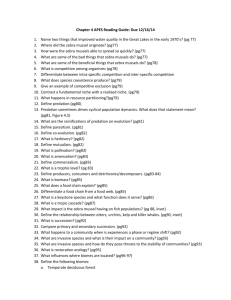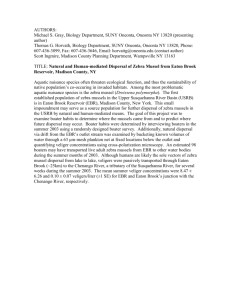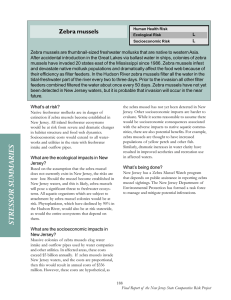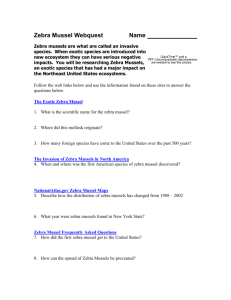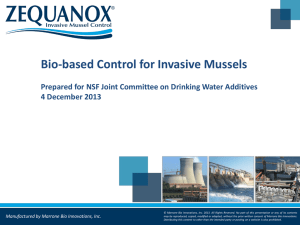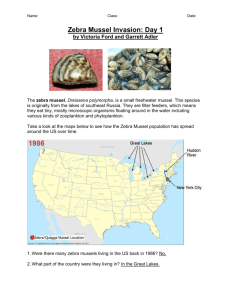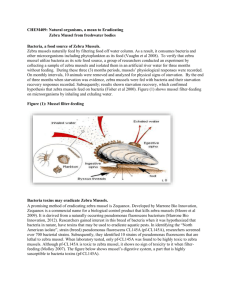Problem 2
advertisement
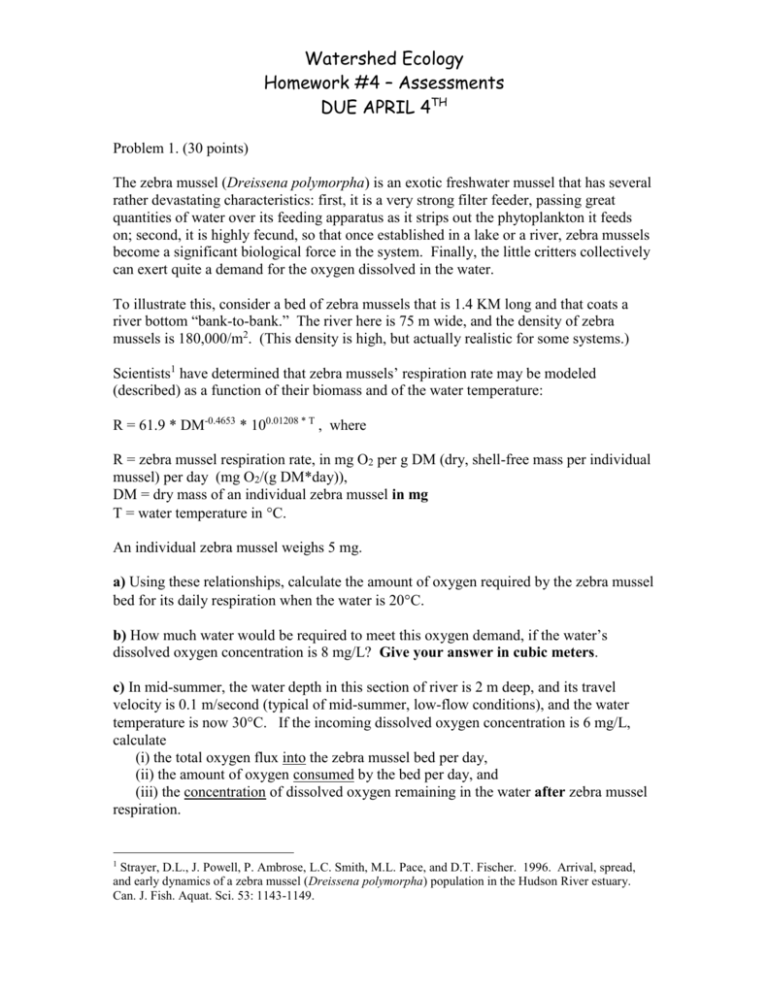
Watershed Ecology Homework #4 – Assessments DUE APRIL 4TH Problem 1. (30 points) The zebra mussel (Dreissena polymorpha) is an exotic freshwater mussel that has several rather devastating characteristics: first, it is a very strong filter feeder, passing great quantities of water over its feeding apparatus as it strips out the phytoplankton it feeds on; second, it is highly fecund, so that once established in a lake or a river, zebra mussels become a significant biological force in the system. Finally, the little critters collectively can exert quite a demand for the oxygen dissolved in the water. To illustrate this, consider a bed of zebra mussels that is 1.4 KM long and that coats a river bottom “bank-to-bank.” The river here is 75 m wide, and the density of zebra mussels is 180,000/m2. (This density is high, but actually realistic for some systems.) Scientists1 have determined that zebra mussels’ respiration rate may be modeled (described) as a function of their biomass and of the water temperature: R = 61.9 * DM-0.4653 * 100.01208 * T , where R = zebra mussel respiration rate, in mg O2 per g DM (dry, shell-free mass per individual mussel) per day (mg O2/(g DM*day)), DM = dry mass of an individual zebra mussel in mg T = water temperature in C. An individual zebra mussel weighs 5 mg. a) Using these relationships, calculate the amount of oxygen required by the zebra mussel bed for its daily respiration when the water is 20C. b) How much water would be required to meet this oxygen demand, if the water’s dissolved oxygen concentration is 8 mg/L? Give your answer in cubic meters. c) In mid-summer, the water depth in this section of river is 2 m deep, and its travel velocity is 0.1 m/second (typical of mid-summer, low-flow conditions), and the water temperature is now 30C. If the incoming dissolved oxygen concentration is 6 mg/L, calculate (i) the total oxygen flux into the zebra mussel bed per day, (ii) the amount of oxygen consumed by the bed per day, and (iii) the concentration of dissolved oxygen remaining in the water after zebra mussel respiration. 1 Strayer, D.L., J. Powell, P. Ambrose, L.C. Smith, M.L. Pace, and D.T. Fischer. 1996. Arrival, spread, and early dynamics of a zebra mussel (Dreissena polymorpha) population in the Hudson River estuary. Can. J. Fish. Aquat. Sci. 53: 1143-1149. Problem #2. (30 points) In class, we went over how to use a single tracer to separate out two sources of water (hydrograph separation). Now we’ll use two tracers to determine the amount of water and nutrients contributed by three different sources of water: rainwater (r), ground water (gw), and soil water (s). The tracers we will use are silicate (SiO2, measured as mg Si/L) and the stable isotopic ratio of oxygen (18O, measured in per mille (‰)). We solve for three equations: The total discharge is the sum of the three source flows Qt = Qr + Qs + Qgw . We can determine two of the three source flows by solving one with the stable isotopic tracer, a second one with the silicate tracer, and the third by difference. Here we’ll use the 18O to solve for Qr and the silicate to solve for Qgw. The equations are Qr Qt ( t gw ) Qs ( s gw ) ( r gw ) Qgw Qt ( Sit Sir ) Qs ( Sis Sir ) ( Sigw Sir ) , where the “” stands for “18O”, and , with the silicate concentration in mg/L. You obtain a data set by sampling the silicate and 18O in the end members (rain, soil water, and ground water), and sampling these tracers in the stream as well over the course of 7 days. The data for the end members and stream water are in the tables below: del18O Si (mg/L) -7 0.1 Rain -11 2.1 Soil water -12 9.9 GroundH2O Sources: Day 1 2 3 4 5 6 7 Q_t (m3/s) 7.5 22 21 13 8 6 5 del18O -11 -10.2 -9.8 -9.4 -10.1 -10.7 -10.9 Si (mg/L) 3.8 3.9 4.4 4.5 6 7.2 7.7 a) Solve for the component flows of source waters. You will have to solve each day’s flows by an iterative (repetitive) process. Because both the Qr and the Qgw equations rely on Qs, you will have to put in a guess for Qs as you solve for these. Then, once you have your equations for rain and groundwater flows, you can adjust the value of Qs until all three of these flows add up to Qt. Make a graph of the three component discharges. If you are using Excel, use the Area Graph to “stack” the discharges on top of each other, so you can see the sum total as well. As a check, you can make a plot of Qt as well and compare it with your component graph. b) In addition, you measured the concentration of total nitrogen (N, in mg/L) in the source waters: Sources: N (mg/L) 1.4 Rain 5 Soil water 3 GroundH2O Calculate the flux of N (grams/second) from each source water. Then compute the concentration of N (mg/L) in Qt. (Hint: how do you convert from mg/L to g/m3 ? Once you have that, the rest should fall out…)
